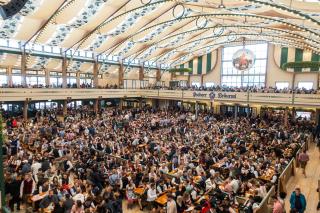What people wear at the Oktoberfest in Munich
Oktoberfest outfit: Costumes, dresses and lederhosen
As far as the outfit at the Oktoberfest is concerned, it is impossible to imagine the festival without Bavarian traditional costumes. Young people in particular have made wearing "dirndl" and "lederhosen" at the Oktoberfest popular again. What you need to know about wearing traditional costumes:

More actions
Do you have to wear traditional costume at the Oktoberfest?
No. The modern traditional costumes (whether Dirndl or Lederhosen) have become more and more popular as an article of clothing in recent years. However, there is no dress code at the Oktoberfest, so any outfit is allowed for partying.
What is the meaning of "dirndl" bows?
Women can use bows on their dirndls (traditional Bavarian dresses) to indicate their relationship status. However, this unofficial custom is not regulated as mandatory. Thus, the wearers can also put on their bows accordingly for other reasons. Generally, the following bow positions are interpreted in this way (the position applies from the point of view of the person wearing the dirndl).
Meaning of the dirndl bow:
- Dirndl bow tied on the left: The wearer is single.
- Dirndl bow tied on the right: The wearer is already taken, engaged or married.
- Dirndl bow tied in the center back: The wearer is a waitress or widowed.
What belongs to dirndl and lederhosen?

The history of dirndls and lederhosen (leather pants) at the Oktoberfest in Munich goes back to the early years of the 19th century. Originally worn as work clothes and everyday wear, not least the Oktoberfest in 1810 itself gave a boost to the wearing of traditional costumes among the city's population. Over time, the traditional garments developed into symbols of Bavarian culture and identity.
After various phases of ups and downs, modern traditional costumes with contemporary cuts and fabrics are once again in vogue at the Oktoberfest. However, these often no longer have much in common with the festive attire of the rural population.
- Dirndl: The dirndl developed from peasant clothing. Originally, it was a simple work dress for women that was comfortable and functional. In the 19th century, city dwellers* began to wear it as a fashion statement. A dirndl consists of a top and a long or short skirt. A mostly white blouse is worn with it. An apron emphasizes the skirt and has only decorative purpose. The position of the skirt bow can indicate the relationship status. Accessories such as jewelry complete the look.
- Lederhose: Bavarian leather pants are made of real or artificial leather and have a short leg length. They are often worn with suspenders and feature embellishments and embroidery. In addition to their original function as workwear, leather pants are durable, comfortable and easy to care for. They also offer maximum freedom of movement. The leather pants are often worn with a shirt, vest, a charivari (jewelry chain on the traditional costume), loferl (calf socks) and a traditional hat.
Why should you watch the traditional costume and marksmen parade?
The traditional costumes and historical clothing, especially in the 19th and early 20th centuries in Bavaria, are shown by the costume clubs and rifle associations during the traditional parade on the first Sunday of Oktoberfest. On September 22, 2024, more than 9,000 participants* parade through downtown Munich. Guests from other Alpine countries also march in the procession, which can be up to 7 kilometers long.


